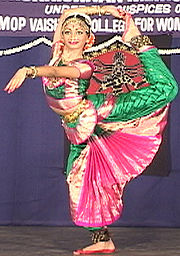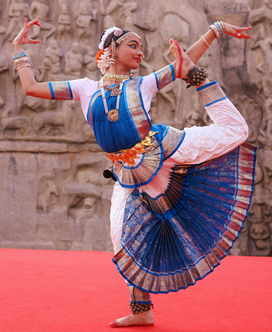
Karana dance
Encyclopedia

Classical Indian dance
Indian classical dance is a relatively new umbrella term for various codified art forms rooted in Natya, the sacred Hindu musical theatre styles, whose theory can be traced back to the Natya Shastra of Bharata Muni .- Definitions :...
described in Natya Shastra
Natya Shastra
The Natya Shastra is an ancient Indian treatise on the performing arts, encompassing theatre, dance and music. It was written during the period between 200 BC and 200 AD in classical India and is traditionally attributed to the Sage Bharata.The Natya Shastra is incredibly wide in its scope...
. Karana is a Sanskrit
Sanskrit
Sanskrit , is a historical Indo-Aryan language and the primary liturgical language of Hinduism, Jainism and Buddhism.Buddhism: besides Pali, see Buddhist Hybrid Sanskrit Today, it is listed as one of the 22 scheduled languages of India and is an official language of the state of Uttarakhand...
verbal noun, meaning "doing". Natya Shastra states that Karanas are the framework for the "margi" (pan-Indian classical) productions which are supposed to spiritually enlighten the spectators, as opposed to the "desi" (regional folk or pop dance) productions which can only entertain the spectators. "One who performs well this Karana dance created by Maheswara will go free from all sins to the abode of this deity" states Natya Shastra
Natya Shastra
The Natya Shastra is an ancient Indian treatise on the performing arts, encompassing theatre, dance and music. It was written during the period between 200 BC and 200 AD in classical India and is traditionally attributed to the Sage Bharata.The Natya Shastra is incredibly wide in its scope...

Padma Subramanyam
Dr. Padma Subrahmanyam , is an Indian classical Bharatanatyam dancer. She is also a research scholar, choreographer, music composer, musician, teacher and author. She is famous in India as well as abroad: several films and documentaries have been made in her honor by countries like Japan, Australia...
that were based on 108 brief movement phrases describing specific leg, hip, body, and arm movements accompanied by hasta mudras
Mudra
A mudrā is a symbolic or ritual gesture in Hinduism and Buddhism. While some mudrās involve the entire body, most are performed with the hands and fingers...
described in the Natya shastra
Natya Shastra
The Natya Shastra is an ancient Indian treatise on the performing arts, encompassing theatre, dance and music. It was written during the period between 200 BC and 200 AD in classical India and is traditionally attributed to the Sage Bharata.The Natya Shastra is incredibly wide in its scope...
and other scriptures, and from depictions of the movements in sculpture in five South Indian temples, notably the Chidambaram temple
Chidambaram Temple
Thillai Natarajah Temple, Chidambaram is a Hindu temple dedicated to Shiva located in the town of Chidambaram, East-Central Tamil Nadu, South India. The temple is known as the foremost of all temples to Saivites and has influenced worship, architecture, sculpture and performance art for over two...
which contains depictions of the full set. Dr. Padma Subrahmanyam has written a book called Karanas-Common dance codes of India and Indonesia, based on her research of karanas from the temples of Prambanan(Indonesia), Thanjavur, Kumbakonam, Chidambaram, Thiruvannamalai and Vriddhachalam. She is the first dancer to reconstruct the Karanas as movements, which were considered to be mere poses earlier. Some other Bharatanatyam
Bharatanatyam
Bharata Natyam or Chadhir Attam, is a classical dance form from the South Indian state of Tamil Nadu, practiced predominantly in modern times by women. The dance is usually accompanied by classical Carnatic music...
gurus, such as Adyar Lakshman (Kalakshetra school) and Sheela Unnikrishnan (Mangudi school), as well as the Kuchipudi guru C.R.Acharya have also attempted to reconstruct all the 108 karanas, which were often significantly different from Padma Subrahmanyam's interpretations. Many of Padma Subrahmanyam's disciples such as Uma Sriram, Sundari Santhanam, Jayashree Rajagopalan and Sujatha Mohan are teaching the 108 karanas based on Dr. Padma's research which is more authentic than the others.
Due to the significant variations in the depictions, most traditional Bharatanatyam schools considered Padma Subrahmanyam's style which incorporated Karanas as incorrect, which forced her to name her own style as Bharatanrityam rather than Bharatanatyam
Bharatanatyam
Bharata Natyam or Chadhir Attam, is a classical dance form from the South Indian state of Tamil Nadu, practiced predominantly in modern times by women. The dance is usually accompanied by classical Carnatic music...
.
While there are still some elderly devadasi
Devadasi
In Hinduism, the devadasi tradition is a religious tradition in which girls are "married" and dedicated to a deity or to a temple and includes performance aspects such as those that take place in the temple as well as in the courtly and mujuvani [telegu] or home context. Dance and music were...
s who perform all the 108 karanas, in most contemporary Bharatanatyam or Odissi schools only 50-60 karanas have been transmitted by parampara
Parampara
Parampara denotes a succession of teachers and disciples in traditional Indian culture and Indian religions such as Hinduism, Sikhism, Jainism and Buddhism...
up to date.
Apart from that, performing of the same karana differ greatly across different classical Indian styles. Currently, as regards the exact technique, there are no established standards and no universally agreed upon interpretations of the texts and sculptures.
External links
- Padma Subrahmanyam, "Bharatha Natyam - Classical Dance of the Ancient Tamils. The Role of Dance Sculptures in Tamilnad (1968) P. Subrahmanyam's introduction, with pictures illustrating 108 karanas.

